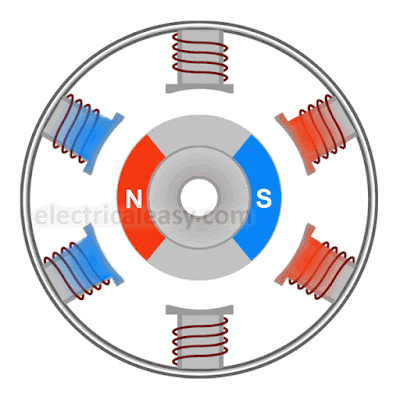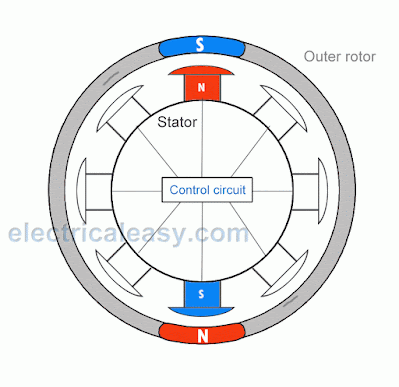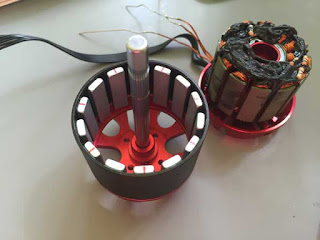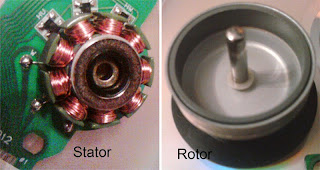Brushless DC (BLDC) Motor – Construction And Working
By Kiran Daware, from electricaleasy.com
Electrical motors have been developed in various special types, such as stepper motors, servo motors, permanent magnet motors, etc. We have a lot of choices to choose a motor that is most suitable for our application. A Brushless DC motor or BLDC motor is the type that is most suitable for applications that require high reliability, high efficiency, more torque per weight, etc. This article explains about BLDC motors in detail.
Construction Of A BLDC Motor
A commutator-brushes arrangement helps in achieving unidirectional torque in a typical dc motor. Obviously, the commutator and brush arrangement are eliminated in a brushless dc motor. Here, an integrated inverter/switching circuit is used to achieve unidirectional torque. That is why these motors are, sometimes, also referred as ‘electronically commutated motors’.
Just like any other electric motor, a BLDC motor also consists of two main parts a stator and a rotor. Permanent magnets are mounted on the rotor of a BLDC motor, and the stator is wound for a specific number of poles. Also, a control circuit is connected to the stator winding. Most of the time, the inverter/control circuit or controller is integrated into the stator assembly. This is the basic constructional difference between a brushless motor and a typical dc motor.
A typical controller provides a three-phase frequency-controlled supply to the stator winding. The supply is controlled by logical control circuits and energizes specific stator poles at a specific point in time. This can be understood from the below animations about the working of BLDC motors.
Types Of BLDC Motors
There are two types of BLDC motors based on their construction/design: (i) inner rotor design & (ii) outer rotor design. Regardless of these types, note that the permanent magnets are always mounted on the rotor and winding on the stator.
- Inner rotor design (inrunner): this is a conventional design, where the rotor is located at the core (center) and stator winding surrounds it.

Inner-rotor BLDC motor (Credit: Kaspars Dambis – flickr) - Outer rotor design (outrunner): In this configuration, the rotor is external. i.e. stator windings are located at the core while the rotor, carrying permanent magnets, surrounds the stator.

Outer rotor BLDC motor
How Does A BLDC Motor Work?
Stator windings of a BLDC motor are connected to a control circuit (an integrated switching circuit or inverter circuit). The control circuit energizes proper winding at the proper time, in a pattern that rotates around the stator. Permanent magnets on the rotor try to align with the energized electromagnets of the stator, and as soon as it aligns, the next electromagnets are energized. Thus, the rotor keeps running. The animations below will give you a clear idea of ‘how a brushless DC motor works?’
 |
| Inner rotor BLDC motor working animation |
 |
| Outer rotor BLDC motor working animation |
Brushless Vs. Brushed DC Motor
- Brushes require frequent replacement due to mechanical wear, hence, a brushed DC motor requires periodic maintenance. Also, as brushes transfer current to the commutator, sparking occurs. Brushes limit the maximum speed and the number of poles the armature can have. These all drawbacks are removed in a brushless DC motor. An electronic control circuit is required in a brushless DC motor for switching stator magnets to keep the motor running. This makes a BLDC motor potentially less rugged.
- Advantages of BLDC motor over brushed motors are increased efficiency, reliability, longer lifetime, no sparking and less noise, more torque per weight, etc.
Applications Of BLDC Motors
BLDC motors fulfill many requirements that a brushed DC motor does. But as they require a complicated control circuit and due to cost considerations, they haven’t yet completely replaced brushed DC motors, especially in low-cost applications. Despite this, there are many applications where BLDC motors dominate –
- Consumer electronics – computer hard drives, small cooling fans, cd/dvd players, etc. and also in modern appliances where quiet operation is desired – such as washing machines, air conditioners, etc.
- Electric Vehicles – many electric vehicles including electric and hybrid cars, electric bikes use BLDC motors.
- They have a wide range of applications in many other areas including robotics, industrial, motion control systems, etc.












